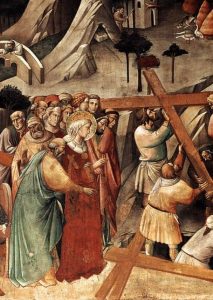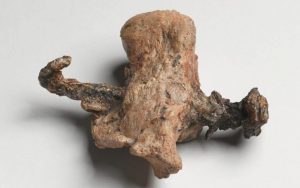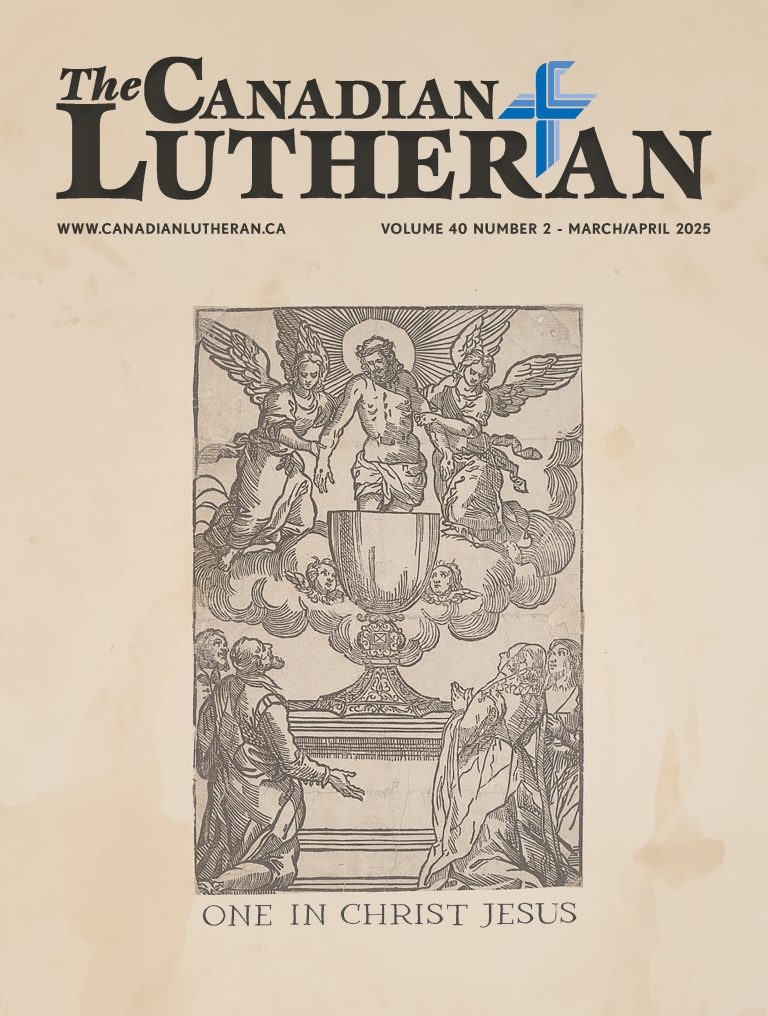The true cross and the Truth

The finding of the true cross (detail). Agnolo Gaddi, 1380s (fresco, The Church of Santa Croce, Florence). Public domain (via Wikipedia)
by Stephen Chambers
The death of Jesus lies at the heart of our faith. In 1 Corinthians, Paul draws on an early creed to remind his hearers that “Christ died for our sins according to the Scriptures” and that “He was buried” (1 Cor 15:3-4). The Apostles’ Creed echoes the same core confession that Jesus “suffered under Pontius Pilate, was crucified, died, and was buried.” The Nicene Creed re-arranges the same elements: Christ “was crucified also for us under Pontius Pilate; he suffered and was buried.” Clearly, Jesus’s death on the cross is central to the whole Church’s confession because it was there, as He suffered and died, that Jesus paid for the sins of the whole world. No wonder Paul wrote to the Corinthians, “I decided to know nothing, while I was among you, except Jesus Christ and Him crucified.” Everything hung on that.
No wonder, either, that Christians have always wanted to find physical evidence of Jesus’ crucifixion. According to the 5th century historian Socrates Scholasticus, the cross on which Jesus died was discovered around the year 325 by Helena, the mother of the emperor Constantine. The story of how she found it is dubious, though it’s not impossible that the local Christian community might have remembered the exact place of His crucifixion for almost 300 years. Nor is it impossible that Socrates might have somehow learned about these events 200 years later. In any case, the place where Helena is supposed to have found the true cross became the site of the Church of the Holy Sepulchre. Most of what came to be called “the true cross” remained in that church, encased in silver, though Helena also took a few fragments of the wood back to Constantinople.
In Luther’s day, Frederick the Wise was famous for having no fewer than 35 fragments of the true cross!
Notoriously, the cross’s fame multiplied as more and more Christians sought to see, honour, and revere the actual implement on which they thought Jesus had died. The section of the cross left in Jerusalem traded hands numerous times from the 7th century onward as Christians, Persians, and Muslims fought for control of the Holy Land. In the year 1110, a tiny piece of this cross was given to the King of Norway, but within a century, the rest of it completely disappeared after being captured by the Muslim general Saladin. Meanwhile, the section taken to Constantinople was further divided into many small pieces following the city’s capture by European knights in 1204. Apparently, knights taking part in the campaign were rewarded for their service by being given little bits of the cross. When they returned home, many donated these fragments to churches and monasteries where they became objects of devoted reverence. In Luther’s day, his protector Frederick the Wise was famous for having in his collection of more than 17,000 holy relics no fewer than 35 fragments of the true cross!
For many reasons, few modern Protestants hold much hope that any of these supposed relics of Jesus’s cross come from the real thing. Even if Helena managed to find the true cross, its subsequent wild ride—and ever-smaller subdivision into hundreds of tiny bits—makes it most unlikely that any of the actual wood that bore Jesus’s dying body has survived. Nor is this just a modern opinion. Already in the mid-4th century, Cyril of Jerusalem noted that “the holy wood of the Cross … [is] now almost filling the whole world, by means of those who in faith take portions from it.” Looking back on the explosion of interest in the wood of the cross during the Middle Ages, John Calvin wryly noted that “if all the pieces that could be found were collected together, they would make a big ship-load!”
The skeletal remains of a young man named Jehohanan help us picture what happened to Jesus as He died.
In archaeological terms it is exceedingly unlikely that anything at all from Jesus cross has survived. There is, however, one undisputed artifact from first-century Palestine that helps us understand what happened to Jesus during His crucifixion. Without shedding direct light on that specific crucifixion, the skeletal remains of a young man named Jehohanan help us in a general way to picture what happened to Jesus as He died.

Jehohanan’s heel-bone, nail, and fragments of wood (replica). Courtesy of The Israel Museum, Jerusalem. Photographer: Ilan Schtulman
Jehohanan’s remains came to light 50 years ago when Israeli archaeologists were excavating a set of tombs in north Jerusalem. Because the human remains in these tombs lay in smallish, rectangular stone boxes known as ossuaries, it was obvious they came from the first century AD, since that is the only time in Jerusalem’s history such boxes were used to re-bury people’s bones, a year or so after their bodies were initially laid to rest in full-sized tombs. Other archaeological clues narrowed down the time of Jehohanan’s death suggesting his burial in the late 20s (A.D.)—within a decade or so of Jesus.
Like Jesus, Jehohanan had been crucified. The proof is in his right heel-bone which is still spiked to a piece of olive-wood by a large iron nail. That nail, 11.5 cm long, bent as it passed through Jehohanan’s heel into something hard, perhaps a knot in the wood. That this inner end of the nail became bent like a fish-hook prevented those charged with disposing of his dead body from extracting the nail from his heel. The whole business—heel-bone, nail, and a bit of the wood—was placed together into the ossuary in which his remains were eventually stored.
Besides this heel-bone, Jehohanan’s remains shed light on Jesus’s crucifixion in three other ways. Both his lower legs were broken reinforcing what the Gospel of John tells us sometimes happened (John 19:31-32). Ordinarily, speeding up a criminal’s death by breaking his legs so he suffocated more quickly was the last thing Romans wanted; the whole point of crucifixion was to impose a death as painful as possible. But the Romans respected the firm Jewish custom, based on Scripture (Deut 21:22-23), that bodies had to be buried by sundown on the eve of the Sabbath—Friday evening. The reason this was not done in Jesus’s case is that He was already dead when the order to do this leg-breaking was given (John 19:33). The fact that Jehohahan’s legs were broken suggests that he was also crucified on a Friday—if these bones were broken before his death. Some forensic specialists think they might have been broken posthumously. There is also a small degree of doubt whether the leg-bones in question belong with Jehohanan’s obviously crucified heel-bone; it’s not impossible that they belong to one of the other two people whose remains eventually shared the same ossuary. If, however, the majority view is correct, then the fact that Jesus’s legs were not broken, while Jehohanan’s were, highlights the importance of the exception. Like the lambs that were sacrificed on the first Passover, so Israel could escape by God’s grace from the land of slavery and death (Exod 12:46), Jesus’s legs too remained unbroken. As Paul says, He is our Passover Lamb, indeed! (1 Cor 5:7)
The contrast with Jesus’s death is striking.
Another point of contact is the fact that Jehohanan’s arms may not have been nailed but tied to the crossbeam. The situation is not clear since there are scratches on the bones of his forearms. These, however, are common on ancient skeletal material and might not be related to the manner of Jehohanan’s death. Some ancient authors describe victims’ hands being nailed, others say they were tied, and still others mention both possibilities. In any case, the contrast with Jesus’s death is striking. A week after His resurrection when Jesus told Thomas, “Put your finger here, and see my hands” (John 20:27), the clear implication is that the nail-holes were still visible. Even if it is hard to discern any theological significance to those specific wounds, the fact that Jesus died a real, cruel, painful death is vitally important. For, as Isaiah prophesied, and Peter solemnly affirmed, “By His wounds we are healed” (Isa 53:5; 1 Peter 2:24).
Finally, the fact that Jehohanan received an honorable burial—despite his crucifixion—indirectly confirms the biblical accounts. Most of the people the Romans crucified in times of insurrection and war were denied a proper burial. But things were different in peacetime. In the 20s and early 30s, when both Jehohanan and Jesus were crucified, the Romans still respected and abided by the Jewish requirement that all dead bodies must be buried. Not even what Paul calls the “scandalous foolishness” of the cross (1 Cor 1:23) prevented Jesus’s loyal friends from laying his body in a proper tomb (John 19:38-42).
In some ways, then, archaeology doesn’t have very much to tell us about Jesus’s death in our place on the cross. There is zero chance anyone will ever find His body because of His resurrection and ascension (Luke 24:1-10, 51; Acts 1:9). The true cross on which He died undoubtedly rotted away to nothing long ago. The best archaeology can do is show us the grievous wounds suffered by one of Jesus’ contemporaries who suffered a strikingly similar death. Even there the parallel is grossly imperfect, for in the death of Christ alone—which is totally unique among the thousands of victims of crucifixion in the ancient world—we find our salvation. As Peter again says with elegant simplicity, “Christ died for sins once for all, the righteous for the unrighteous, to bring us to God” (1 Peter 3:18).
Rev. Dr. Stephen L. Chambers is Professor of Exegetical Theology and Academic Dean at Concordia Lutheran Seminary in Edmonton. He has participated in numerous archaeological digs in the Holy Land.




